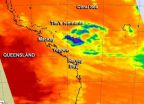(Press-News.org) Microbes from the human mouth are telling Oak Ridge National Laboratory scientists something about periodontitis and more after they cracked the genetic code of bacteria linked to the condition.
The finding, published in Proceedings of the National Academy of Sciences, profiles the SR1 bacteria, a group of microbes present in many environments, ranging from the mouth to deep within the Earth, that have never been cultivated in the laboratory. Human oral SR1 bacteria are elevated in periodontitis, a disease marked by inflammation and infection of the ligaments and bones that support the teeth.
Scientists also found that the SR1 bacteria employ a unique genetic code in which the codon UGA – a sequence of nucleotides guiding protein synthesis -- appears not to serve its normal role as a stop code. In fact, scientists found that UGA serves to introduce a glycine amino acid instead.
"This is like discovering that in a language you know well there is a dialect in which the word stop means go," said co-author Mircea Podar of the Department of Energy lab's Biosciences Division. Podar and Dieter Söll of Yale University led the team that also included scientists from DOE's Joint Genome Institute who contributed to the analysis of the single-cell sequencing data.
The researchers believe the altered genetic code limits the exchange of genes between SR1 and other bacteria because they use a different genetic alphabet.
"In the big pool of bacteria, genes can be exchanged between species and can contribute to increased antibiotic resistance or better adaptation to living in humans," Podar said. "Because SR1 has a change in its genetic alphabet, its genes will not function in other microbes."
Podar and colleagues envision this work providing a path toward a better understanding of microbiological factors of periodontitis as well as to the establishment of a framework to help scientists interpret genomic data from this bacterium and others that have the same altered genetic code.
"So far, no one has been able to isolate and cultivate this type of bacterium," said Podar, who noted that there are bugs in our mouth that we have no clue about and, until now, this was one of them. "The genetic information obtained by sequencing one single cell may offer researchers a key to 'domesticating' these organisms and studying them in the laboratory."
INFORMATION:
The work at ORNL was funded by a $1.2 million National Institutes of Health grant to study human microbes and develop approaches to sequence the genomes of species that have not been cultivated. Other authors are James and Alisha Campbell of ORNL, Patrick O'Donoghue of Yale University, and Patrick Schwientek, Alexander Sczyrba and Tanja Woyke of DOE's Joint Genome Institute (http://www.jgi.doe.gov) in Walnut Creek, Calif.
UT-Battelle manages ORNL for DOE's Office of Science. The Office of Science is the single largest supporter of basic research in the physical sciences in the United States and is working to address some of the most pressing challenges of our time. For more information, please visit http://science.energy.gov/.
END
PROVIDENCE, R.I. [Brown University] — Large chunks of an ancient tectonic plate that slid under North America millions of years ago are still present under parts of central California and Mexico, according to new research led by Brown University geophysicists.
Around 100 million years ago, the Farallon oceanic plate lay between the converging Pacific and North American plates, which eventually came together to form the San Andreas fault. As those plates converged, much of the Farallon was subducted underneath North America and eventually sank deep into the mantle. Off ...
Infrared satellite imagery tells the temperature of the cloud tops within a tropical cyclone as well as the sea surface temperatures around the storms. A recent infrared image from NASA's Aqua satellite showed very little strength in the remnants of ex-cyclone Tim offshore from southeastern Queensland.
The Atmospheric Infrared Sounder (AIRS) instrument aboard NASA's Aqua satellite captured an infrared image of Cyclone Tim on March 18 at 0355 UTC (March 17 at 11:55 p.m. EDT). The AIRS image showed that cloud top temperatures had warmed significantly since the previous ...
A study in the JAMA Neurology (formerly the Archives of Neurology) suggests that controlling or preventing risk factors such as hypertension earlier in life may limit or delay the brain changes associated with Alzheimer's disease and other age-related neurological deterioration.
Dr. Karen Rodrigue, assistant professor in the UT Dallas Center for Vital Longevity (CVL), was lead author on a study that looked at whether people with both hypertension and a common gene associated with risk of Alzheimer's disease (the APOE-4 gene carried by about 20 percent of the population) ...
Stingrays living in one of the world's most famous and heavily visited ecotourism sites — Stingray City/Sandbar in the Cayman Islands — have profoundly changed their ways, raising questions about the impact of so-called "interactive ecotourism" on marine wildlife, reports a new study published March 18 in the journal PLOS ONE.
Researchers from Nova Southeastern University's Guy Harvey Research Institute in Hollywood, Fla., and the University of Rhode Island studied the southern stingray population of Stingray City — a sandbar in the Cayman Islands that draws nearly a ...
Lowering the costs of healthy foods in supermarkets increases the amount of fruits, vegetables and whole grain foods that people eat, while also appearing to reduce consumption of nutritionally less-desirable foods, according to research from the RAND Corporation.
Researchers examined a program available to members of South Africa's largest private health insurance company that provides a rebate of 10 percent or 25 percent on purchases of healthy foods. The program, started in 2009, now has about 800 participating supermarkets and enrolls more than 260,000 households. ...
CHICAGO — Many of today's running shoes feature a heavy cushioned heel. New research presented today at the 2013 Annual Meeting of the American Academy of Orthopaedic Surgeons (AAOS) found that these shoes may alter an adolescent runner's biomechanics (the forces exerted by muscles and gravity on the skeletal structure) and diminish performance.
Researchers recruited 12 adolescent competitive athletes from local track teams, and asked them to run on a treadmill in large heel trainers, track flats and without any shoes (barefoot) at four different speeds. Biomechanics ...
CHICAGO — Osteoarthritis of the hip or knee, affecting millions of Americans each year, is known to limit sexual activity. New research presented today at the 2013 Annual Meeting of the American Academy of Orthopaedic Surgeons (AAOS) found that total hip (THR) or total knee replacement (TKR) surgery improves sexual function in 90 percent of patients.
In the study, 147 patients under age 70, scheduled for primary THR or TKR, agreed to participate in a study requiring the completion of questionnaires prior to surgery, at six months post surgery, and at one year post surgery. ...
CHICAGO — New research presented today at the at the 2013 Annual Meeting of the American Academy of Orthopaedic Surgeons (AAOS) found that overall, sports and recreation musculoskeletal injuries have declined 12.4 percent in the U.S. over the past 10 years for children ages 5 to 14 years. However, injuries sustained during football and soccer continues to rise.
In 2000, the U.S. Centers for Disease Control (CDC) reported the top eight sports and recreational activities responsible for injuries in children ages 5 to 14, and estimated their annual cost at more than $33 ...
CHICAGO – Magnetic Resonance Imaging (MRI) can detect a failing, or potentially failing, metal-on-metal hip implant (MoM) early on, according to a new study presented today at the 2013 Annual Meeting of the American Academy of Orthopaedic Surgeons (AAOS). Early detection can result in timely revision surgery, decreasing the risk for further tissue damage and pain.
Researchers reviewed the MRI images of 70 patients who ultimately underwent revision surgery for a failed MoM implant. The images were assessed for the presence of tissue damage, swelling and other characteristics. ...
CHICAGO – High-energy lower-extremity trauma (HELET) is common in modern warfare, often resulting in severe tissue damage, chronic pain, neurovascular injury and significant muscle loss, according to the new research presented today at the 2013 Annual Meeting of the American Academy of Orthopaedic Surgeons (AAOS).
The Return to Run (RTR) program is an integrated orthotic and rehabilitation initiative designed to return high-level function to wounded warriors. It includes use of the new Intrepid Dynamic Exoskeletal Orthosis (IDEO), a custom-fit device made from carbon ...


